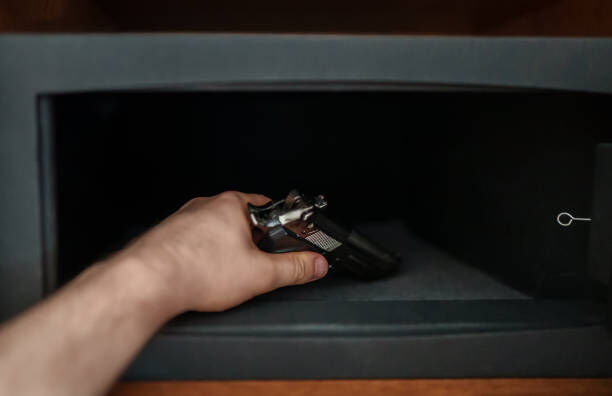
Man puts the weapon in the safe.
Ensuring firearms are safe and secure is a growing concern for homeowners. The gun safe industry plays a vital role by offering products that protect firearms from unauthorized access, theft, and damage. With increased awareness of firearm safety, proper gun safe installation has become essential for responsible owners. This not only ensures secure storage but also complies with legal requirements aimed at preventing misuse.
Installing a gun safe, along with other home safes, represents a commitment to personal and community safety. Key factors include choosing the right location, ensuring structural support, and employing effective anchoring techniques. Utilizing modern technology can also enhance gun safe effectiveness.As demand grows, many homeowners turn to trusted gun safes that offer both robust protection and user-friendly features. The following tips will help achieve a balance between security and functionality, empowering homeowners to foster a culture of safety in firearm ownership.
Choosing the Right Location
When picking the best spot for your gun safe, you need to find a balance between easy access and security. Look for a place that doesn't stand out but is still reachable in an emergency. Good options might include a hidden corner in the basement or a discreet area in a walk-in closet.
Consider who will need access and how quickly they might need to get to the firearm. Safety should always come first, so choose a secure environment. Look for places where the safe can be hidden but still easily accessible. Avoid common break-in targets like the garage or a visible office space. Also keep in mind that heavier safes are harder for burglars to move.
Ensuring Strong Structural Support
Checking your home's structural integrity is a must before installing a gun safe. Ensure your floors and walls can handle the weight of a heavy safe for safety and stability. Learn about your home's building materials; for instance, wooden floors may need extra support for larger safes, while concrete floors should be inspected for cracks or weak spots.
Consider the location of supporting beams, as placing the safe directly over them can help distribute weight and reduce damage risk. If support is lacking, adding steel reinforcements can increase load capacity. While assessing structural support may seem straightforward, it requires careful thought and possibly consulting a structural engineer.
Anchoring the Safe Correctly

An automatic pistol handgun with a gun safe and shooting equipment.
To properly anchor your gun safe, choose a secure location away from busy areas or where it can be easily seen. Mark where to drill using the pre-drilled holes in the safe’s base as a guide. Use a drill to create holes for heavy-duty bolts, ensuring they go deep enough for a strong hold. High-quality bolts designed for securing heavy items are essential, as regular hardware may not be strong enough.
Consider how different materials affect anchoring: concrete floors are stable but may require special drill bits, while wooden floors can splinter or sag and may need extra support. Properly anchoring your safe transforms it from a movable object into a fixed part of your home, significantly improving security and overall safety.
Maintaining Accessibility and Functionality
The main purpose of a gun safe is to keep firearms secure while allowing authorized users quick access in emergencies. To balance accessibility and security, careful planning and modern solutions are essential. Consider using smart locks or biometric technology to enable fast access without compromising safety, ensuring only approved individuals can open the safe.
Placing the gun safe in a location that allows for quick access during stressful situations can enhance its effectiveness. It's also important to have a clear plan for how authorized family members can safely access firearms, and everyone should practice this plan. Combining technology with traditional security methods offers both convenience and peace of mind, ensuring firearms are accessible to you while remaining secure from unauthorized access.
Utilizing Technological Enhancements
Using modern technology in your gun safe is a smart way to improve security. For instance, biometric access lets you unlock the safe with your fingerprint or retina scan, making it accessible only to certain people. This not only makes the safe more secure but also speeds up access, which can be vital in emergencies.
Additionally, connecting your safe to smart home devices can enhance its features. You can monitor who accesses it and receive alerts on your smartphone, giving you peace of mind when you’re not home. However, while these advancements make safes more secure, they also raise issues like power needs and potential hacking risks. Still, combining technology with traditional safety practices creates a strong system that meets the needs of modern gun owners.

A revolver handgun with a gun safe and shooting equipment.
Regular maintenance and proper installation of gun safes are key for responsible firearm ownership. As more individuals recognize the importance of securing their firearms, understanding the specifics of gun safe upkeep becomes essential. By choosing the right location, ensuring strong structural support, anchoring the safe correctly, maintaining accessibility, and utilizing technological advancements, gun owners can significantly enhance their security measures. These practices not only protect firearms from unauthorized access and damage but also promote a culture of safety within the home. Ultimately, investing time and effort into gun safe management is a commitment to responsible ownership and community safety.




Post a comment as Guest
Report
Watch this discussion.
(0) comments
We welcome your comments
Log In
Post a comment as Guest
Keep it Clean. Please avoid obscene, vulgar, lewd, racist or sexually-oriented language.
PLEASE TURN OFF YOUR CAPS LOCK.
Don't Threaten. Threats of harming another person will not be tolerated.
Be Truthful. Don't knowingly lie about anyone or anything.
Be Nice. No racism, sexism or any sort of -ism that is degrading to another person.
Be Proactive. Use the 'Report' link on each comment to let us know of abusive posts.
Share with Us. We'd love to hear eyewitness accounts, the history behind an article.